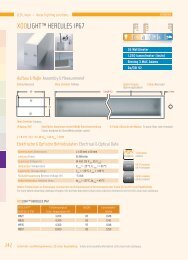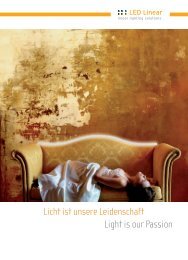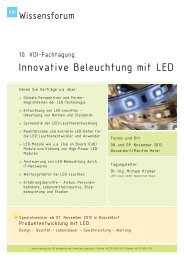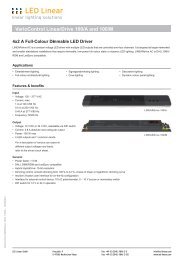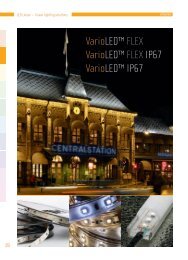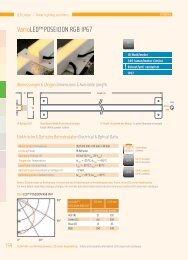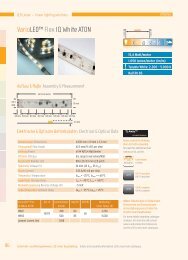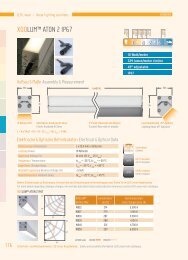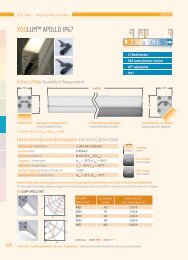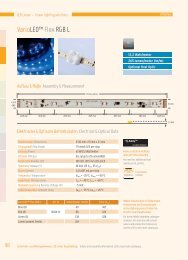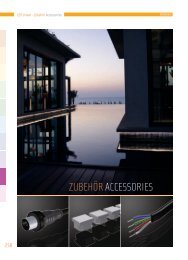Hauptkatalog - LED Linear
Hauptkatalog - LED Linear
Hauptkatalog - LED Linear
You also want an ePaper? Increase the reach of your titles
YUMPU automatically turns print PDFs into web optimized ePapers that Google loves.
27/08/2012<br />
LM-80 prescribes uniform test methods for <strong>LED</strong> manufacturers<br />
under controlled conditions for measuring <strong>LED</strong> lumen<br />
maintenance while controlling the <strong>LED</strong>‘s TS or case<br />
temperature, the DC forward voltage and forward current to<br />
the <strong>LED</strong>. LM-80 requires 55°C, 85°C and one other TS chosen<br />
by the <strong>LED</strong> manufacturer. It also requires lumen maintenance<br />
data out to at least 6,000 hours of constant DC mode (not<br />
pulse mode) operation 4.<br />
Many of <strong>LED</strong> <strong>Linear</strong> Japanese <strong>LED</strong> suppliers chose 120°C for<br />
the third TS for their <strong>LED</strong> and they have recorded data out to<br />
10,000 hours which is the preferred duration in LM-80. Based<br />
upon LM-80 data, <strong>LED</strong> manufacturers then extrapolate lumen<br />
maintenance out to tens of thousands of hours;<br />
Our <strong>LED</strong> suppliers go out to 50,000 hours and beyond.<br />
While LM-80 does not specify the extrapolation method,<br />
many <strong>LED</strong> manufacturers use more conservative exponential<br />
extrapolation due to the exponential behavior of <strong>LED</strong>s and<br />
most electronic components. The SSL Subcommittee is<br />
working on TM-21 which will standardize this extrapolation<br />
method.<br />
The data resulting from LM-80 measurements are matrices<br />
of lumen maintenance values. <strong>LED</strong> fixture manufacturers use<br />
this data in combination with their UL in-situ thermal testing<br />
to predict the lumen maintenance of the <strong>LED</strong>s when used in<br />
their fixtures and, subsequently, the lumen maintenance of<br />
the <strong>LED</strong> fixtures themselves. For example, if we measure 85°C<br />
TS at the hottest <strong>LED</strong> <strong>Linear</strong> <strong>LED</strong> in one of our fixtures, then we<br />
look up that particular data set from our Japanese suppliers<br />
to determine the <strong>LED</strong> fixture’s lumen maintenance based upon<br />
and correlated with the <strong>LED</strong>’s lumen maintenance at that<br />
same TS. Fixture manufacturers also use the data to predict<br />
<strong>LED</strong> color stability over time at the various TS temperatures.<br />
<strong>LED</strong> <strong>Linear</strong> – linear lighting solutions<br />
LM-79-08 for the <strong>LED</strong> fixture<br />
<strong>LED</strong> lumen maintenance and color stability are only part<br />
of the puzzle. It is helpful to characterize the performance<br />
of <strong>LED</strong>s in fixtures so that the entire system is considered.<br />
That‘s where LM-79 comes in.<br />
LM-79-08 Approved Method: Electrical and Photometric<br />
Measurements of Solid-State<br />
Lighting Products was published by the IESNA Solid State<br />
Lighting (SSL) Subcommittee in the first quarter of 2008.<br />
LM-79 covers photometric and colorimetric performance<br />
as well as electrical power measurements for inorganic <strong>LED</strong><br />
fixtures 5. LM-79 prescribes uniform test methods for <strong>LED</strong><br />
fixture manufacturers under controlled conditions using<br />
<strong>LED</strong> fixtures as they would be manufactured for production.<br />
Unlike traditional sources which are typically tested using<br />
relative photometry with test lamps and ballasts, <strong>LED</strong> fixtures<br />
are tested using absolute photometry with production <strong>LED</strong>s<br />
and fixtures in the orientation in which it will be installed to<br />
ensure a more true test of <strong>LED</strong> performance when in situ.<br />
As previously discussed, <strong>LED</strong>s operated in situ will perform<br />
differently due to the elevated Tj which will be further<br />
impacted by fixture orientation and thermal conditions; if<br />
the <strong>LED</strong> array or module were removed from the fixture, its<br />
performance would change. This is precisely why absolute<br />
photometry is a must for <strong>LED</strong> fixtures.<br />
LM-79 testing is typically performed with either an integrating<br />
sphere for all photometric and colorimetric measurements or<br />
an integrating sphere in combination with a goniophotometer.<br />
The integrating sphere is recommended for colorimetric<br />
measurements; alternately, a goniospectroradiometer or<br />
gonio-colorimeter may be used. <strong>LED</strong> <strong>Linear</strong> has an integration<br />
sphere for all colorimetric, radiometric and photometric<br />
measurements for single <strong>LED</strong>s and a custom designed<br />
goniophotometer lab and equipment where we test <strong>LED</strong><br />
fixtures following LM-79 procedures. We also test key <strong>LED</strong><br />
fixtures in independent DOE approved labs – look for the<br />
.ies photometric files on our web site that indicate LM-79.<br />
357



